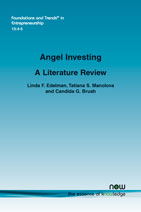Angel Investing: A Literature Review
By Linda F. Edelman, Bentley University, USA, ledelman@bentley.edu | Tatiana S. Manolova, Bentley University, USA, tmanolova@bentley.edu | Candida G. Brush, Babson College, USA, cbrush@babson.edu
Abstract
Even though scholars have amassed a large body of research on angel investors, few systematic and comprehensive reviews are available. The purpose of this monograph is to review this literature and then to offer suggestions for future investigation. To that end, we compiled a set of journal articles on angel investing. We start with Wetzel’s (1983) seminal article describing the characteristics of angel investors and end with the work published more recently. In total, we have 152 articles that we review. For parsimony, we chose to focus our review only refereed journal articles, thereby excluding conference proceedings, books and book chapters, industry reports, and dissertations. This implies that there is additional work that has been done on the topic of angel investing that is not covered by our monograph. For this, we offer our apologies. However, we did include studies using data from the Global Entrepreneurship Monitor (GEM) because these capture early stage financing globally. GEM defines angel investment a little differently than we do in the monograph, in that in GEM they include early stage family and friends money as angel investment. This is likely due to the international nature of the GEM data collection and the lack of a robust angel investment community internationally. In the final chapter, we have included a table that breaks out the GEM studies, to better represent the data.
Angel Investing: A Literature Review
Angel Investing provides systematic and comprehensive review of the large body of research literature on angel investors. Based on the analysis and consideration of previous literature reviews, the authors created an organizing framework that captures the major aspects of the angel investment landscape including the major perspectives in angel investing: the angel investors (including angel networks and angel groups), the entrepreneurs and their ventures, the relationship and decision-process between angels and entrepreneurs, and performance.
Angel Investing begins with a look at the angel investors themselves and the market characteristics that lead to angel investing. Section 2 focuses on the contributions made by angels as well as subgroups of angel investors, such as women and micro-angels. Section 3 discusses angel networks and public policy implications. Section 4 explores different typologies of angels, focusing on their reasons for investing and on some differences between angel investors and venture capitalists. Section 5 shifts focus to examine the other side of the dyad – the entrepreneurial firms – and reviews the literature that explores the firms that are seeking angel money. Section 6 moves back to the angels examining the decision making process in angel investing. Section 7 reviews the articles that look at angel investor and firm performance. Section 8 reviews the methodologies used by the researchers in the angel investor literature, thereby illustrating how the data collection and analytic tools have both changed and remained the same over time and then offers conclusions about the literature as well as suggestions for future research. The last section highlights the key and most critical issue around the angel investment literature – the lack of generalizable data and a dearth of strong methods. Each section provides a set of summary tables to aid the reader. These tables include every article reviewed in that section, the bibliographic data, main research question, theoretical perspective if applicable, and a summary of the findings.
